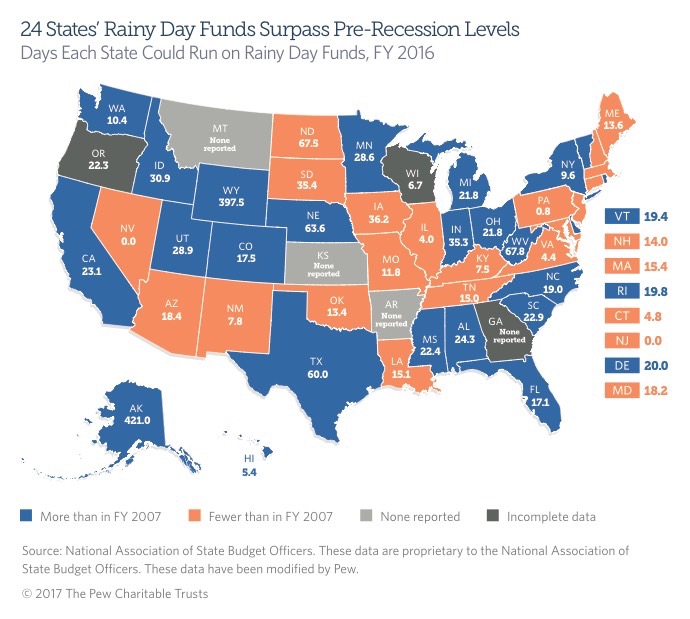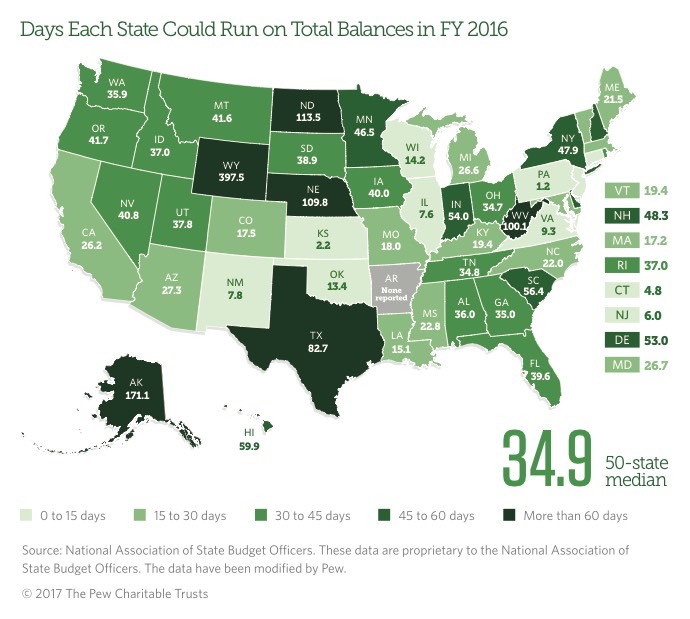Connecting state and local government leaders
At least 24 states ended fiscal 2016 with larger rainy day funds as a share of operating costs than before the 2007-09 downturn.
This article was originally published by States' Fiscal Health, an initiative of The Pew Charitable Trusts, and was written by Barb Rosewicz, Jonathan Moody and Daniel Newman.
States have made progress toward replenishing their rainy day funds since the Great Recession, but most still have thinner financial cushions than they did before the downturn. At the close of fiscal year 2016, total balances in states’ general fund budgets—including rainy day funds—were large enough to run government operations for a median of 34.9 days, compared with 40.7 days in fiscal 2007.
At the close of fiscal 2016, only 15 states had a bigger cushion in their budgets than they had before the recession. The remaining states could cover fewer days’ worth of operating costs than in fiscal 2007 with their total balances, counting money saved in rainy day reserves plus general fund ending balances, which are the amounts left at the end of the budget year in what functions as a state’s main checking account.
After tax revenue plunged in the recession, states tapped both their savings and ending balances to help plug huge gaps that opened in their budgets. As state revenue has slowly recovered, so have their reserves and balances—largely because most states have made efforts to rebuild their rainy day funds over the past seven years of economic recovery. At least 24 states ended fiscal 2016 with larger rainy day funds as a share of operating costs than before the 2007-09 downturn.

Rainy Day Funds
Reserves in rainy day funds—also called budget stabilization funds—were the largest component of states’ financial cushions in fiscal 2016, accounting for nearly $2 of every $3 of total balances. The importance of rainy day funds in helping to gird against budget uncertainties has grown since the recession. Slow and uneven tax revenue growth has limited most states’ ability to match their large ending balances in the year before the downturn. Rainy day funds typically provide a stable cushion from year to year, while ending balances are more volatile and harder to predict.
Nationally, rainy day funds held $48.2 billion in fiscal 2016—more than before the recession in both nominal dollars and as a share of government expenditures, according to data collected by the National Association of State Budget Officers (NASBO). States had set aside enough in these funds to run operations for a median of 17.9 days in fiscal 2016, or 4.9 percent of general fund spending—more than a median of 16.5 days or 4.5 percent of spending in fiscal 2007.
Since the Great Recession, most states have been rebuilding their rainy day funds, as they did after the 2001 recession. However, a number have struggled to save given sluggish tax revenue growth. For example, Pennsylvania drained its rainy day fund in fiscal 2010 to help ease the budget crunch it faced as a result of the recession and has managed to replenish it with less than a day’s worth of spending since then. Other states have had to make more recent withdrawals. Nine states tapped their rainy day funds in fiscal 2016, according to NASBO. Alaska, which has one of the largest rainy day funds in the country, made the biggest withdrawal. The state, which depends on oil-based revenue to fund much of its operations, drew down more than a third of its savings in fiscal 2016 to cover a significant budget gap caused by low oil prices.
Rainy Day Fund Highlights
States’ latest results for rainy day funds in fiscal 2016—though still subject to change—show:
- Alaska could cover the most days’ worth of spending (421 days) despite drawing down more than $3.8 billion in fiscal 2016 to cover ongoing budget shortfalls stemming from a decline in oil-related revenue. This was the second year in a row that the state withdrew from its rainy day reserves, which shrank to their lowest level as a share of operating costs since 2008.
- Wyoming (397.5 days) was the only other state with more than a year’s worth of operating costs in its rainy day fund. Although the state has added to its savings in recent years, its reserves show a substantial increase since 2015 largely because it updated how it reports its data to NASBO. As a result, current figures are not directly comparable to earlier totals.
- Seven states’ rainy day funds could cover more days’ worth of operating costs than at any point since at least 2000: Alabama (24.3 days), Hawaii (5.4 days), Idaho (30.9 days), Indiana (35.3 days), North Carolina (19.0 days), Ohio (21.8 days), and Wyoming (397.5 days).
- Two states had nothing in their savings accounts—Nevada and New Jersey—and six held less than a week’s worth of operating costs: Connecticut (4.8 days), Hawaii (5.4 days), Illinois (4.0 days), Pennsylvania (0.8 days), Virginia (4.4 days), and Wisconsin (6.7 days).
- Arkansas, Georgia, Kansas, and Montana did not report rainy day fund totals to NASBO.
- According to NASBO, the nine states that tapped their rainy day funds to manage their budgets were: Alaska, Connecticut, Louisiana, Mississippi, New Mexico, Oklahoma, South Dakota, Washington, and West Virginia.
Total Balances
States’ total balances stood at $73.3 billion in fiscal 2016, and they held enough funds to cover operating expenditures for a median of 34.9 days. This amounted to 9.6 percent of spending, less than the fiscal 2007 median of 40.7 days, or 11.1 percent. But for many states, even pre-recession total balances were inadequate to plug budget gaps that opened as a result of the Great Recession.
Although just 15 states’ total balances provided a larger financial cushion than before the recession, reserves and balances continued to grow nationally as the median number of days that states could operate on these balances reached the highest level since 2007. Growing rainy day funds helped spur the increase as ending balances in most states were lower than in previous years. For example, Texas has one of the largest rainy day funds but experienced especially large declines in ending balances amid a revenue slowdown.
Since ending balances vary from year to year, they do not necessarily represent how much a state has stowed away but can serve as an indicator of budget stress. Often these funds can be available for a state to use in a budget crunch and provide an additional source of fiscal flexibility. According to NASBO, Alaska and Connecticut ended fiscal 2016 with negative ending balances, which is an indication that each faced revenue shortfalls at the close of the budget year.
Enacted budgets for fiscal 2017 show that at least 37 states anticipated lower total balances relative to operating expenditures than in fiscal 2016. Those balances, however, are based on amounts appropriated in state budgets and routinely change significantly by the close of the fiscal year.
Total Balance Highlights
States’ latest results for their total balances in fiscal 2016—though still subject to change—show:
- Wyoming for the first time led the nation with the largest total balance as a share of operating costs—397.5 days’ worth.
- Alaska’s total balance fell to second—171.1 days’ worth of operating costs. This was the fourth year in a row that it dropped, putting the figure at its lowest level since at least 2000. The state still has the largest rainy day fund (421 days), but total balances were smaller because it closed the fiscal year with a revenue shortfall of nearly $3 billion.
- Three additional states also had total balances that could cover more than 100 days of operating costs: Nebraska (109.8 days), North Dakota (113.5 days), and West Virginia (100.1 days).
- Besides Alaska, New Mexico (7.8 days) also saw its financial cushion shrink to its lowest level since at least 2000.
- The smallest total balances—less than a week’s worth of operating costs—were held by Connecticut (4.8 days), Kansas (2.2 days), New Jersey (6.0 days), and Pennsylvania (1.2 days).
- Three states’ total balances could cover more days’ worth of operating costs than at any point since at least 2000: New Hampshire (48.3 days), New York (47.9 days), and Wyoming (397.5 days). New York’s total spiked in recent years because of one-time payments it collected from legal settlements reached with financial institutions.

Why Reserves Matter
States use reserves and balances to manage budgetary uncertainty, deal with revenue forecasting errors, prevent severe spending cuts or tax increases when there are unexpected revenue shortfalls, and cope with unforeseen emergencies. Because reserves and balances are vital to managing unexpected changes and maintaining fiscal health, their levels are tracked closely by bond rating agencies. For example, Moody’s Investors Service downgraded New Mexico’s credit rating in October 2016, citing “the depletion of general fund reserves following a very large and unanticipated shortfall in tax revenues for fiscal 2016 and 2017.”
Building up reserves is a sign of fiscal recovery, but there is no one-size-fits-all rule on when, how, and how much to save. States with a history of significant revenue or economic volatility may desire larger cushions. According to a December 2015 report by The Pew Charitable Trusts, the optimal savings target of state rainy day funds depends on three factors: the explicitly defined purpose of funds, the volatility of a state’s tax revenue, and the level of coverage—similar to an insurance policy—that the state seeks to provide for its budget.
General fund reserves and balances may not reflect a state’s complete fiscal cushion. States may have additional resources to soften downturns, such as dedicated reserves outside of their general funds or rainy day accounts. In addition, some states undertake considerable spending outside of the general fund, so comparisons across states should be made with caution. One way to standardize the size of reserves and balances is to calculate how many days a state could run solely on those funds, even though it is highly unlikely that would ever happen.
Download the data to see individual state trends. Visit Pew's interactive resource Fiscal 50: State Trends and Analysis to sort and analyze data for other indicators of state fiscal health.

NEXT STORY: Why Would Congress Bail Out Miners’ Pensions?



